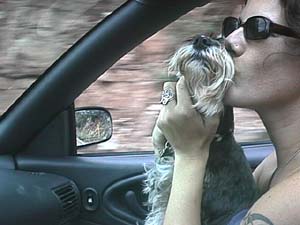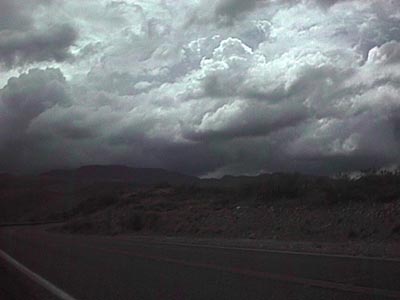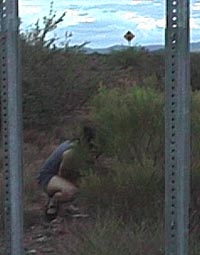|
|
|
desert sight seeing
Sunday, July 11 1999
This morning Kim and I weren't burdened by Sophie, so we could leisurely enjoy an outdoor breakfast with the other high brow people staying at the Briar Patch Inn. The amplified classical duet were back in full effect, playing mellow classical numbers while we sipped our coffee and nibbled at our exceptional cinnamon rolls. I noticed that the violinist was playing a six string violin or viola. I'd never seen such a thing in my life, and I hung out in Oberlin, land of the cutting edge music device, for a good five years.
A few weak drops of rain began to fall and naturally a good many of those around us fled, for to sit sipping coffee in the rain is a little too much like the life their wealth is supposed to prevent them from living. The manager of the Briar Patch Inn, a spritely (I love that word!), slightly effeminate guy with an inexplicable mulletesque hairdo, was rushing about constantly, making everyone feel thoroughly fussed-over. It was actually a better experience than I'm letting on. One thing I will definitely say about the Briar Patch Inn is that it feels like every dollar of the money you're spending, which is especially remarkable given that there's no television and no telephone.
On a whim, Kim and I waded through the fairly deep fast-flowing cold water of Oak Creek to the east shore and romped around upon an impressive field of rounded boulders, looking for treasures such as interestingly pebbles. The floodplain forest was rather similar to similar forests in the East, though there were no hemlocks but instead occasional Prickly Pear cacti and a western species of pine. The sycamores (California sycamores I think) were far and away the most common species of tree. As we crossed the creek to return to our cabin, I slipped on an extremely slick rock and fell on my side into the frigid water. Kim, who was crossing the treacherous creek wearing a skirt, also experienced difficulty staying dry.
We'd be leaving Sedona and the Briar Patch Inn today, and check-out time was noon. At the office as Kim settled up, she inquired about perhaps reserving one of the fancy cabins for next year. She also inquired about perhaps getting a cabin for 01/01/00, but of course the place is already booked solid then.
Wordlessly saying goodbye to Sedona, we headed west to Cottonwood. But we didn't stop there, not even to pick up our beloved Sophie languishing at the Doggie Dude Ranch. You see, we needed a little more time to explore Arizona doggie-free. We continued on westward to the town of Jerome, which sits high on the same north-south ridge that serves as a backdrop for the town of Cottonwood. While Cottonwood in the valley is at about 3300 ft. elevation, Jerome is 2000 feet higher, a full mile above sea level. Upon the triangular peak above Jerome is an enormous J drawn in whitewashed stones. I soon noticed that all the towns in this area have their first letter drawn in white stones on their highest hill, yet another interesting custom of the wild west.
Jerome is perhaps the hilliest town you can expect to find anywhere in America. Seated on the side of a steep semi-arid mountain, it's main street zig-zags higher and higher up the hill, with adjacent segments very close to one another but at such different elevations as to make them functionally remote.
The reason there's a town at all on this steep barren mountain is the presence of a substantial deposit of copper beneath it. A huge mining operation once supported a city of some 15,000 people, but the mine closed after World War II and now the population is more like 500, mostly artists, antique vendors, restaurant workers, and others supported by the substantial tourist trade. The mine itself is now a state park, and after the long climb into Jerome, this is where Kim and I went to have a picnic lunch. When I briefly crossed a fence to take a piss, I found that the slope beneath the glitzy renovated mine museum was largely covered with the hardy exotic mint horehound, the same plant that thrived in my parents' overgrazed, overfertilized pastures in Virginia.
Off in the hazy distance we could see the weird landforms of Sedona, though they occupied such a small fraction of the background that seemed like an almost inappropriate aberration, like a painter's error.
While my expectations were for Jerome to be something of a ghost town, it seemed to me at least as vital as any similar-looking town back East, which may say more about the ghostlike qualities of Staunton, Virginia and Mannington West Virginia than it does about the vitality of Jerome). On this Sunday, with clouds threatening from on high, Jerome seemed to be full of people. Most of them were clearly from out of town, having come here to see a quaint montane ghost town. But there was enough of the genuine grittiness of Jerome's own culture showing through to keep things interesting. Up further from the art stores and antique vendors, in a corner bar/former brothel known as the Spirit Room, a long line of Harley Davidsons were parked and from the open door came the blare of live 50s-style rock and roll. We went in to have a listen and drink some Coronas.
The band was known as the Cadillac Angels. Their front man was dressed all in black and had a sort of Buddy Holly haircut, while a woman slapped and plunked a huge stand-up bass with remarkable fury. They seemed to be having a good time, interspersing comments about good towns to break down in between their songs, which varied from western-influenced 50s rock and roll to surf. The crowd was mostly bikers and their girlfriends, but they weren't nearly as ugly as the average Ocean Beach Harley dude with which I'm familiar.
Not far from the Spirit Room, Kim and I actually encountered a some evidence of a bygone era. There were may empty lots that had clearly once contained buildings. They were like gaps in a redneck's smile. In one such gap, barricaded behind behind iron rails, several toilets and even an old vintage outhouse had been set up with signs urging us to throw our coins for charity. In another such gap, a black and white alley cat was catching a nap. He looked up at me through runny eyes and then went back to sleep.
We drove back down the mountain to Cottonwood to pick up Sophie.
She hadn't made a very good impression with her stern dog trainer captors; one of them admitted that she'd been up barking all night. From the other room we could hear her hoarse voice demanding to be let out to greet us.
Our ultimate destination was Phoenix, where we'd be spending the night with Kim's aunt Rhonda. I know, I know, after our last experience there I swore I'd never go back, but I didn't exactly do any of the planning for this vacation.
To get to Phoenix, I wanted to go through Prescott to the west and head south. I'd heard Prescott mentioned often in the context of Earth First! activities (my parents were big into Earth First! back in the early 80s), so I at least wanted to see the place.
For some reason I assumed that the mountain range behind Jerome was a narrow ridge or a quick climb to the top of a plateau, but it was neither. The peak upon which the Jerome J sat was just what was visible from the valley around Cottonwood. But beyond Jerome, the highway wound another ten miles horizontally and another 1700 vertically to the crest of the ridge at 7000 feet above sea level. We were low on gas as we began the climb, and as we continued up the steep slope into an increasingly remote territory (the likes of which I have never seen in the East), both of us were getting pretty nervous we would never find a gas station in time. Near the cloud-licked crest, tall pine trees suddenly became abundant and remained so for some distance down the west side. The westerly winds tend to force rain out of the clouds on western slopes disproportionally both here and in the East.
This accounts for the relatively low rainfall of Virginia's Shenandoah Valley, the easternmost valley of the Appalachians. Charlottesville, which sits just beyond the last ridges of the Blue Ridge, would be even dryer than the Shenandoah Valley were it not for the influence of the ocean and the many storms of tropical origin that creep up from the general vicinity of Lynchburg to the southwest.
It was all downhill into the mile-high Prescott Valley. Again, we had that distinctly western experience of seeing the towns of Prescott Valley and Prescott many miles before we actually made it there. The first thing we did when we got to Prescott Valley (established 1966) was stop at a gas station for essentials like gas and beer. I'd blown all my money a long time ago and was depending on Kim for all purchases. (This had already precluded me from buying her jewelry at an antique store in Jerome.)
Prescott and its environs seems like a terrible remote place, like a godforsaken settlement on another planet. Parts of the terrain even look like another planet. There's a low, steep ridge of some sort of creepy-looking rock protruding improbably from the middle of the otherwise flat valley floor and it seems to run right through the middle of town. If I was a religious man, I'd see that ridge as concrete proof for the existance of Satan.
I found myself thinking about the sort of person who would live in this empty, marginal land. What kind of person would, upon finding himself in the desolate middle of the continent with the trail leading off to the horizon to a place where things have to be better, decide that he'd gone far enough?
The East, as we know, was populated mostly by risk-taking white settlers fleeing poverty in Europe, along with Africans hardy enough to survive the horrors of weeks spent marinading in the hold of a slave ship. But once these people made it to eastern North America, the temperate climate, the good soil and sufficient rainfall (and, at least for the white people, the politics) provided the potential for great prosperity. To leave the East in search of something even better, especially back when the East was still somewhat underpopulated, was the desire of yet a different sort of person.
The climate of the East, even in parts of the South, is fairly harsh, even by European standards. So it's natural that some people, especially those with a hankering for the climate of Western Europe, would seek the West Coast. Some of those people made it all the way, some stopped in Missouri, and every now and then, perhaps, one of them settled in northern Arizona. Those people were not normal, though, and it's I imagine their descendants carry traces of that lack of normality in their genes.
Also, despite all the clichés about America being a place of religious tolerance, it's always been a hotbed of both religious splinter groups and of intolerance. Some sects, such as the Mormons, left the East in search of freedom to worship. They didn't much care where they ended up so long as it was far from where they'd begun, and even the desert was acceptable. But to bullheadedly decided to live in the desert for purely spiritual reasons is also an abnormal decision.
Thinking these things, I would look out the window at the other cars on the road and think about how alien these people must be to decide to live here.
It's important to qualify all of this with the fact that my mother spent several years as an art teacher in Yuma, Arizona, in the heart of the low desert. But I've never made any claims to be anything other than abnormal myself.
After some vaguely commercial miles in the southern outskirts of Prescott, we followed route 69 down to I-17, which then led us into the low desert. I remembered from the time we'd passed through here before the exact ridge where we'd see the first Saguaro cactus as 3000 ft elevation.
We were lost briefly on the outskirts of Scottsdale, which was sort of difficult considering that everything around, between and including Scottsdale and Phoenix is arranged in a perfect compass-direction grid (with the exception of allowances for several steep hills made of solid alien rock sticking up out of the flatness of the desert plain). But that's were a random businessman at a gas station stepped in with detailed directions to the Gainey Ranch, the upscale gated community where Kim's Aunt Rhonda lives.
Rhonda wasn't there, but she'd left a key to her apartment with the strictly no-nonsense guard at the gate. Soon enough we were in Rhonda's apartment being suspiciously interrogated by Raven, Rhonda's lone surviving ten year old miniature Schnauzer (Raven's partner in crime, Demi, died not too long ago after a lingering illness).
The biggest change in Rhonda's life since last we saw her was the success of her Arabian horse, Pashanata, at a grand national horse show held some months ago in Kentucky. Pashanata had won the title of Grand National Champion in Western Pleasure, a honour so great that it had raised Rhonda to the status of second-tier celebrity in the Western Horse world, a world with which I have some passing familiarity given the horse fanaticism of my own dear mother. On Rhonda's mantlepiece was an impressive statue honouring her horse, and on her coffee table were stacks of magazines, all shot full of bookmarks to articles and advertisements crowing her success.
When Rhonda finally showed up, she in the company of a fifty-something dude named Bob who looked like the aging "VP of Marketing Number One" from my place of employment, right down to the red face. Though he appeared to be a good deal older than her, I assumed they were lovers immediately. However, despite his wishes to the contrary, this wasn't true; he was just a friend and his job was mainly to pick up the tab whenever Rhonda (or Rhonda plus Rhonda's contingent) went to restaurants. Take heart, Jessika, it's still possible to have rocky shores at the age of 47.
We all went out for sushi together, and though Bob was giving indications that he didn't want to come along, Rhonda somehow turned him around. And yes, he picked up the tab as well. (By the way, I wonder what it's like to be a fish in one of those big aquaria you see sometimes behind the bar at a sushi restaurant.)
When Rhonda wasn't talking about her infernal horses, she was telling us about a new diet that she's on. The diet is based on the peculiar notion that acid foods are bad for you and alkaline foods are good for you. Hearing Rhonda explain the underlying theory, I nearly cringed at her ignorance of Chemistry. One of the "facts" supposedly underlying the Alkaline diet was that acids promote the growth of Candida yeast. But I know that just the opposite is true; for example, healthy vaginas are naturally acidic specifically to prevent the growth of yeast. But, it's important to note, the Alkaline diet theory isn't based entirely on Chemistry; it is also supported by experiments where various foods had their Kirlian auras photographed and compared.
Back at Rhonda's apartment, Kim and I suffered through a long, arduous presentation of all of Pashanata's horsey achievements. The presentation included a brief but extremely dull professionally-filmed videotape of Pashanata's offspring (born back in February). It showed the young horse trotting around in slow motion while the song "Unforgettable" served as a soundtrack. Even worse was a videotape of Pashanata winning the Grand National Championship. The cameraman stayed glued to Pashanata throughout the entire event, even when interesting things that I would have preferred seeing were happening to other horses.
When we'd seen all the horse videotapes, we were expected to gush over magazine articles. Then, when the horse stuff was done, we were expected to look at stuff related to Rhonda's sister's new Schnauzer puppy. Knowing I had to get up early to make a morning flight back to San Diego, I desperately wanted show and tell to end, yet I felt an obligation to continue watching.
Also, of course, it was the anniversary of the day Kim and I met. Despite the grinding presentation, we somehow managed to work in a certain amount of celebration of that important event. By the way, even when it's not 7-11, we take special notice of 7:11, usually (but not always) in the evening.

The J above Jerome, Arizona.

I pose in front of an old car in Jerome, Arizona.

Motorcycles in front of the Spirit Room in downtown Jerome.

A very large dog belonging to a guy hanging out with the bikers at the Spirit Room.

Kim kisses Sophie shortly after her liberation from the Doggy Dude Ranch.

Spooky clouds in the Prescott Valley.

I pose at a random place along I-17 somewhere far north of Phoenix.
Yes, that's a Budweiser in my hand. There's a reason there
are so many green signs in Arizona saying "DON'T DRINK AND DRIVE"
- lots of people do it!

We'd stopped here at this random place so Kim could take a pee.
For linking purposes this article's URL is:
http://asecular.com/blog.php?990711 feedback
previous | next |







